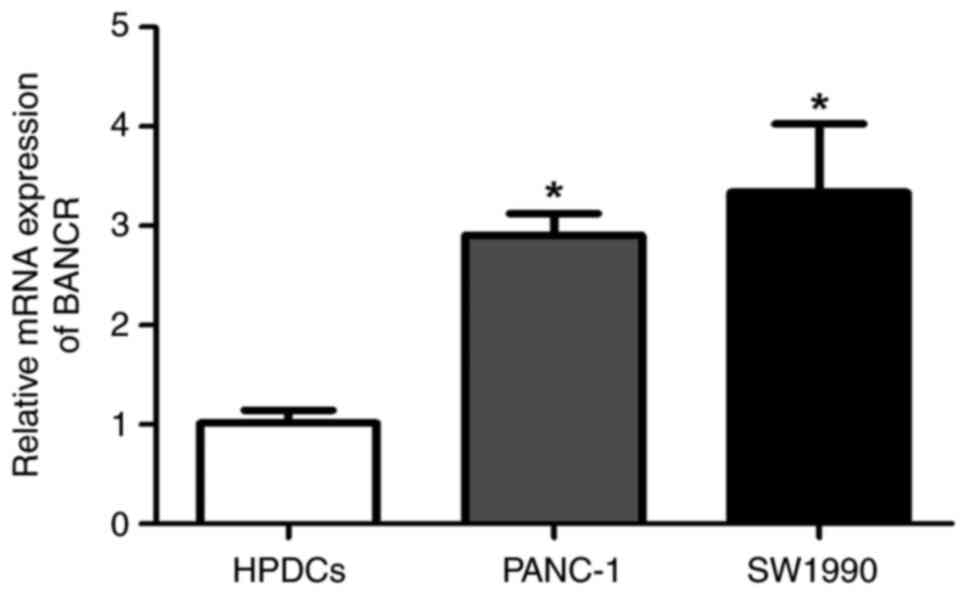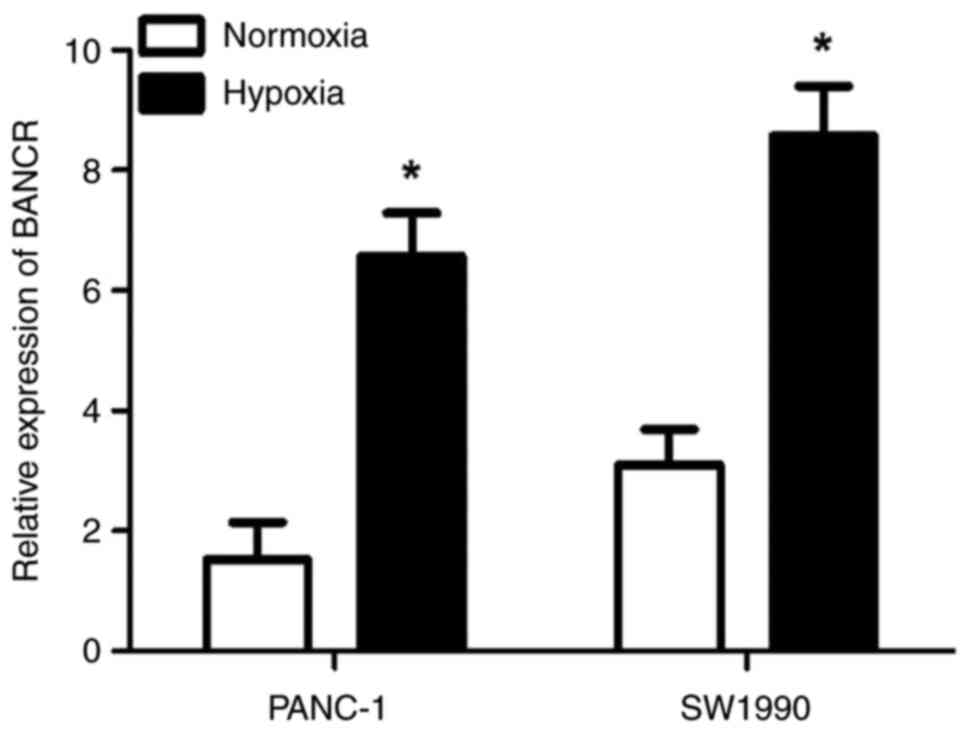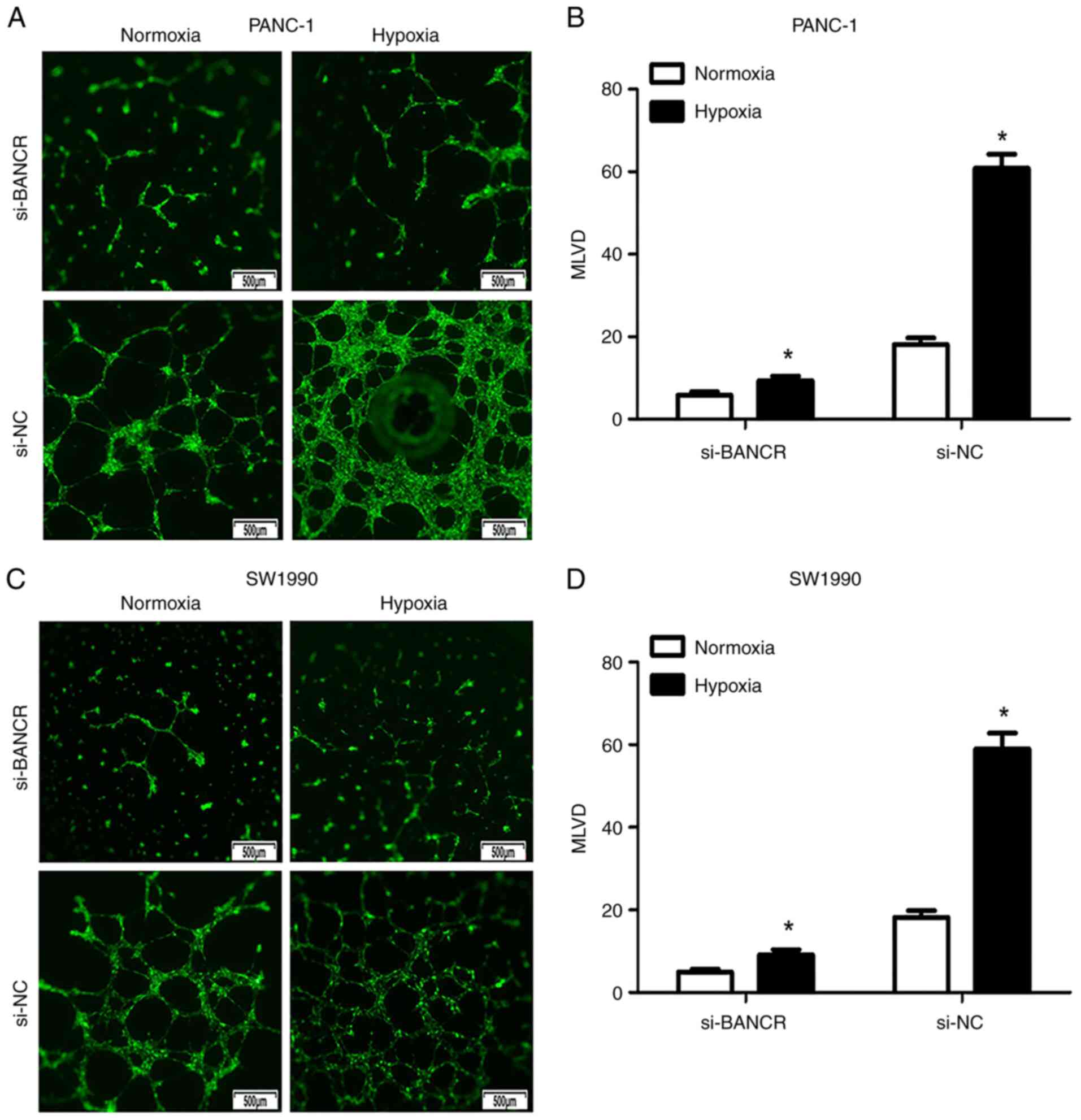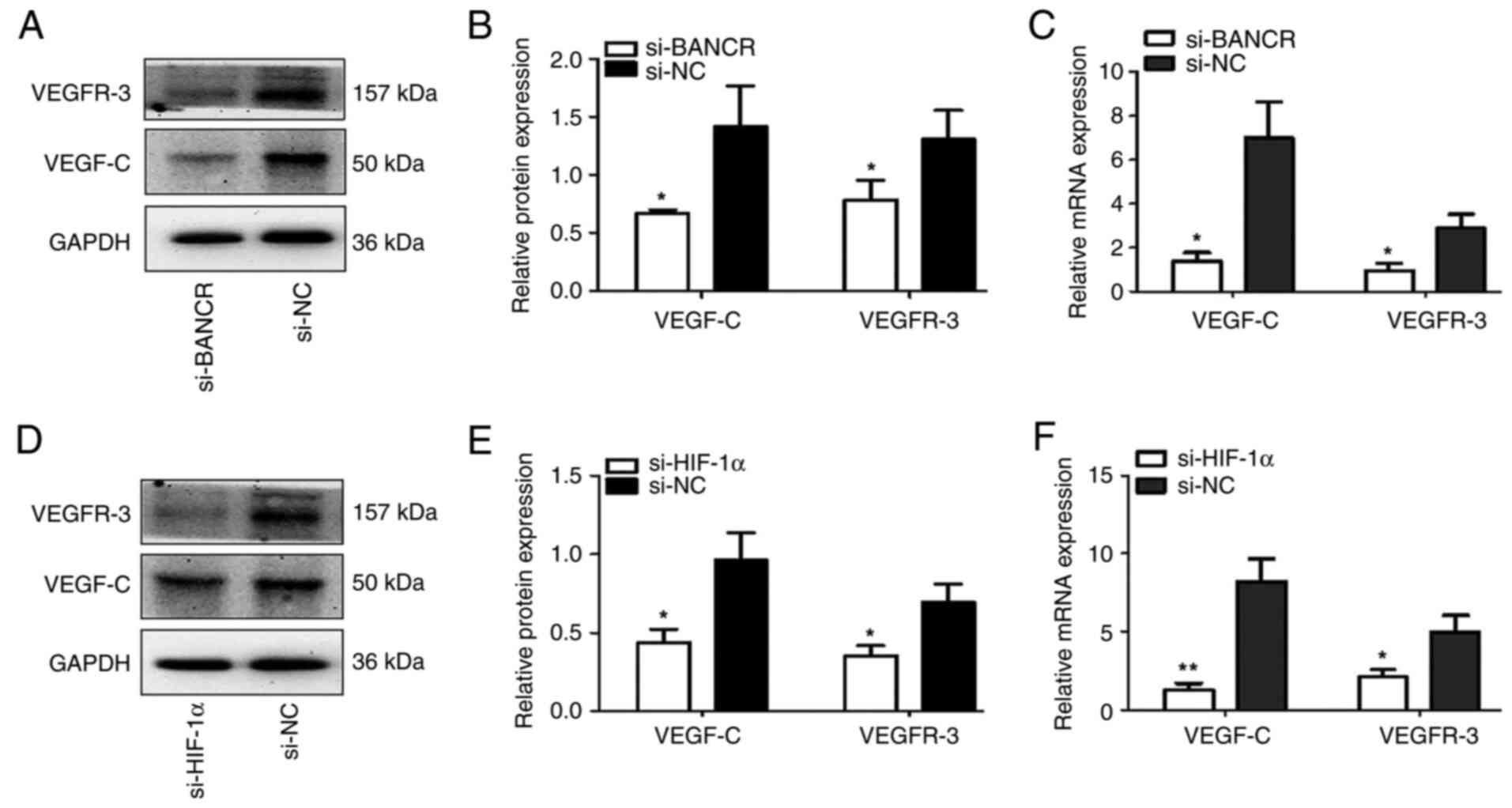|
1
|
Mizrahi JD, Surana R, Valle JW and Shroff
RT: Pancreatic cancer. Lancet. 395:2008–2020. 2020. View Article : Google Scholar : PubMed/NCBI
|
|
2
|
Schwarz RE and Smith DD: Extent of lymph
node retrieval and pancreatic cancer survival: Information from a
large US population database. Ann Surg Oncol. 13:1189–1200. 2006.
View Article : Google Scholar : PubMed/NCBI
|
|
3
|
Chari ST, Sharma A and Maitra A: Early
detection of sporadic pancreatic ductal adenocarcinoma: Problems,
promise, and prospects. Ann Intern Med. 172:558–559. 2020.
View Article : Google Scholar : PubMed/NCBI
|
|
4
|
Wu X, Xia T, Cao M, Zhang P, Shi G, Chen
L, Zhang J, Yin J, Wu P, Cai B, et al: LncRNA BANCR promotes
pancreatic cancer tumorigenesis via modulating
MiR-195-5p/Wnt/β-catenin signaling pathway. Technol Cancer Res
Treat. 18:15330338198879622019. View Article : Google Scholar : PubMed/NCBI
|
|
5
|
Ran S, Volk L, Hall K and Flister MJ:
Lymphangiogenesis and lymphatic metastasis in breast cancer.
Pathophysiology. 17:229–251. 2010. View Article : Google Scholar : PubMed/NCBI
|
|
6
|
Sundar SS and Ganesan TS: Role of
lymphangiogenesis in cancer. J Clin Oncol. 25:4298–4307. 2007.
View Article : Google Scholar : PubMed/NCBI
|
|
7
|
Stacker SA, Williams SP, Karnezis T,
Shayan R, Fox SB and Achen MG: Lymphangiogenesis and lymphatic
vessel remodelling in cancer. Nat Rev Cancer. 14:159–172. 2014.
View Article : Google Scholar : PubMed/NCBI
|
|
8
|
Choi JU, Chung SW, Al-Hilal TA, Alam F,
Park J, Mahmud F, Jeong JH, Kim SY and Byun Y: A heparin conjugate,
LHbisD4, inhibits lymphangiogenesis and attenuates lymph node
metastasis by blocking VEGF-C signaling pathway. Biomaterials.
139:56–66. 2017. View Article : Google Scholar : PubMed/NCBI
|
|
9
|
Ochi N, Matsuo Y, Sawai H, Yasuda A,
Takahashi H, Sato M, Funahashi H, Okada Y and Manabe T: Vascular
endothelial growth factor-C secreted by pancreatic cancer cell line
promotes lymphatic endothelial cell migration in an in vitro model
of tumor lymphangiogenesis. Pancreas. 34:444–451. 2007. View Article : Google Scholar : PubMed/NCBI
|
|
10
|
Kung JT, Colognori D and Lee JT: Long
noncoding RNAs: Past, present, and future. Genetics. 193:651–669.
2013. View Article : Google Scholar : PubMed/NCBI
|
|
11
|
Jiang J, Shi SH, Li XJ, Sun L, Ge QD, Li C
and Zhang W: Long non-coding RNA BRAF-regulated lncRNA 1 promotes
lymph node invasion, metastasis and proliferation, and predicts
poor prognosis in breast cancer. Oncol Lett. 15:9543–9552.
2018.PubMed/NCBI
|
|
12
|
Shen X, Bai Y, Luo B and Zhou X:
Upregulation of lncRNA BANCR associated with the lymph node
metastasis and poor prognosis in colorectal cancer. Biol Res.
50:322017. View Article : Google Scholar : PubMed/NCBI
|
|
13
|
Flockhart RJ, Webster DE, Qu K,
Mascarenhas N, Kovalski J, Kretz M and Khavari PA: BRAFV600E
remodels the melanocyte transcriptome and induces BANCR to regulate
melanoma cell migration. Genome Res. 22:1006–1014. 2012. View Article : Google Scholar : PubMed/NCBI
|
|
14
|
Fang S, Liu Z, Guo Q, Chen C, Ke X and Xu
G: High BANCR expression is associated with worse prognosis in
human malignant carcinomas: An updated systematic review and
meta-analysis. BMC Cancer. 20:8702020. View Article : Google Scholar : PubMed/NCBI
|
|
15
|
Fan YH, Ye MH, Wu L, Wu MJ, Lu SG and Zhu
XG: BRAF-activated lncRNA predicts gastrointestinal cancer patient
prognosis: A meta-analysis. Oncotarget. 8:6295–6303. 2017.
View Article : Google Scholar : PubMed/NCBI
|
|
16
|
Zhou T and Gao Y: Increased expression of
LncRNA BANCR and its prognostic significance in human
hepatocellular carcinoma. World J Surg Oncol. 14:82016. View Article : Google Scholar : PubMed/NCBI
|
|
17
|
Liu ZH, Yang TX, Xu ZP, Lv J, Cao XF, et
al: Long non-coding RNA BANCR expression in esophageal squamous
cell carcinoma and its effects on cell growth and invasion. Prog
Mod Biomed. 16:4622–4627. 2016.(In Chinese).
|
|
18
|
Lou KX, Li ZH, Wang P, Liu Z, Chen Y, Wang
XL and Cui HX: Long non-coding RNA BANCR indicates poor prognosis
for breast cancer and promotes cell proliferation and invasion. Eur
Rev Med Pharmacol Sci. 22:1358–1365. 2018.PubMed/NCBI
|
|
19
|
Zheng H, Xu J, Hao S, Liu X, Ning J, Song
X, Jiang L and Liu Z: Expression of BANCR promotes papillary
thyroid cancer by targeting thyroid stimulating hormone receptor.
Oncol Lett. 16:2009–2015. 2018.PubMed/NCBI
|
|
20
|
Stojanović S, Šelemetjev S, Đorić I,
Rončević J, Janković Miljuš J, Živaljević V and Išić Denčić T:
Elevated BANCR expression levels have different effects on
papillary thyroid carcinoma progression depending on the presence
of the BRAFV600E mutation. Eur J Surg Oncol. 46:1835–1842. 2020.
View Article : Google Scholar : PubMed/NCBI
|
|
21
|
Koong AC, Mehta VK, Le QT, Fisher GA,
Terris DJ, Brown JM, Bastidas AJ and Vierra M: Pancreatic tumors
show high levels of hypoxia. Int J Radiat Oncol Biol Phys.
48:919–922. 2000. View Article : Google Scholar : PubMed/NCBI
|
|
22
|
Dauer P, Nomura A, Saluja A and Banerjee
S: Microenvironment in determining chemo-resistance in pancreatic
cancer: Neighborhood matters. Pancreatology. 17:7–12. 2017.
View Article : Google Scholar : PubMed/NCBI
|
|
23
|
Kang G, Hu M, Ren H, Wang J, Cheng X, Li
R, Yuan B, Balan Y, Bai Z and Huang H: VHH212 nanobody targeting
the hypoxia-inducible factor 1α suppresses angiogenesis and
potentiates gemcitabine therapy in pancreatic cancer in vivo.
Cancer Biol Med. 18:772–787. 2021. View Article : Google Scholar : PubMed/NCBI
|
|
24
|
Yang QK, Wang XX, Wang Y and Ni N:
Integrative analysis reveals the landscape of hypoxia-inducible
factor (HIF) family genes in pan-cancer. J Oncol. 2020:88731042020.
View Article : Google Scholar : PubMed/NCBI
|
|
25
|
Semenza GL: Targeting HIF-1 for cancer
therapy. Nat Rev Cancer. 3:721–732. 2003. View Article : Google Scholar : PubMed/NCBI
|
|
26
|
Harris AL: Hypoxia-a key regulatory factor
in tumour growth. Nat Rev Cancer. 2:38–47. 2002. View Article : Google Scholar : PubMed/NCBI
|
|
27
|
Ye LY, Zhang Q, Bai XL, Pankaj P, Hu QD
and Liang TB: Hypoxia-inducible factor 1α expression and its
clinical significance in pancreatic cancer: A meta-analysis.
Pancreatology. 14:391–397. 2014. View Article : Google Scholar : PubMed/NCBI
|
|
28
|
Jin X, Dai L, Ma Y, Wang J and Liu Z:
Implications of HIF-1α in the tumorigenesis and progression of
pancreatic cancer. Cancer Cell Int. 20:2732020. View Article : Google Scholar : PubMed/NCBI
|
|
29
|
Liu M, Zhong J, Zeng Z, Huang K, Ye Z,
Deng S, Chen H, Xu F, Li Q and Zhao G: Hypoxia-induced feedback of
HIF-1α and lncRNA-CF129 contributes to pancreatic cancer
progression through stabilization of p53 protein. Theranostics.
9:4795–4810. 2019. View Article : Google Scholar : PubMed/NCBI
|
|
30
|
Livak KJ and Schmittgen TD: Analysis of
relative gene expression data using real-time quantitative PCR and
the 2(−Delta Delta C(T)) method. Methods. 25:402–408. 2001.
View Article : Google Scholar : PubMed/NCBI
|
|
31
|
Liu HD, Zhao LH, Zhang YF, Li YL, Li XD,
Yang SC, Li YM and Nie CS: Morphologic features of lymphatic in
periphery region of gastric carcinoma and colon carcinoma. Ai
Zheng. 24:699–703. 2005.PubMed/NCBI
|
|
32
|
Sipos B, Kojima M, Tiemann K, Klapper W,
Kruse ML, Kalthoff H, Schniewind B, Tepel J, Weich H, Kerjaschki D
and Klöppel G: Lymphatic spread of ductal pancreatic adenocarcinoma
is independent of lymphangiogenesis. J Pathol. 207:301–312. 2005.
View Article : Google Scholar : PubMed/NCBI
|
|
33
|
Keklikoglou I, Hosaka K, Bender C, Bott A,
Koerner C, Mitra D, Will R, Woerner A, Muenstermann E, Wilhelm H,
et al: MicroRNA-206 functions as a pleiotropic modulator of cell
proliferation, invasion and lymphangiogenesis in pancreatic
adenocarcinoma by targeting ANXA2 and KRAS genes. Oncogene.
34:4867–4878. 2015. View Article : Google Scholar : PubMed/NCBI
|
|
34
|
Yang H, Kim C, Kim MJ, Schwendener RA,
Alitalo K, Heston W, Kim I, Kim WJ and Koh GY: Soluble vascular
endothelial growth factor receptor-3 suppresses lymphangiogenesis
and lymphatic metastasis in bladder cancer. Mol Cancer. 10:362011.
View Article : Google Scholar : PubMed/NCBI
|
|
35
|
Winder T and Lenz HJ: Vascular endothelial
growth factor and epidermal growth factor signaling pathways as
therapeutic targets for colorectal cancer. Gastroenterology.
138:2163–2176. 2010. View Article : Google Scholar : PubMed/NCBI
|
|
36
|
Zhang G and Cai J: Evaluation of
prognostic value of lncRNA BANCR in tumor patients: A systematic
review and meta-analysis. J BUON. 24:2553–2559. 2019.PubMed/NCBI
|
|
37
|
Cheng P, Jin G, Hu X, Shi M, Zhang Y, Liu
R, Zhou Y, Shao C, Zheng J and Zhu M: Analysis of tumor-induced
lymphangiogenesis and lymphatic vessel invasion of pancreatic
carcinoma in the peripheral nerve plexus. Cancer Sci.
103:1756–1763. 2012. View Article : Google Scholar : PubMed/NCBI
|
|
38
|
Nakajima T, Anayama T, Koike T, Shingyoji
M, Castle L, Kimura H, Yoshino I and Yasufuku K: Endobronchial
ultrasound doppler image features correlate with mRNA expression of
HIF1-α and VEGF-C in patients with non-small-cell lung cancer. J
Thorac Oncol. 7:1661–1667. 2012. View Article : Google Scholar : PubMed/NCBI
|
|
39
|
Schoppmann SF, Fenzl A, Schindl M,
Bachleitner-Hofmann T, Nagy K, Gnant M, Horvat R, Jakesz R and
Birner P: Hypoxia inducible factor-1alpha correlates with VEGF-C
expression and lymphangiogenesis in breast cancer. Breast Cancer
Res Treat. 99:135–141. 2006. View Article : Google Scholar : PubMed/NCBI
|
|
40
|
Katsuta M, Miyashita M, Makino H, Nomura
T, Shinji S, Yamashita K, Tajiri T, Kudo M, Ishiwata T and Naito Z:
Correlation of hypoxia inducible factor-1alpha with lymphatic
metastasis via vascular endothelial growth factor-C in human
esophageal cancer. Exp Mol Pathol. 78:123–130. 2005. View Article : Google Scholar : PubMed/NCBI
|
|
41
|
Jun JC, Rathore A, Younas H, Gilkes D and
Polotsky VY: Hypoxia-inducible factors and cancer. Curr Sleep Med
Rep. 3:1–10. 2017. View Article : Google Scholar : PubMed/NCBI
|



















